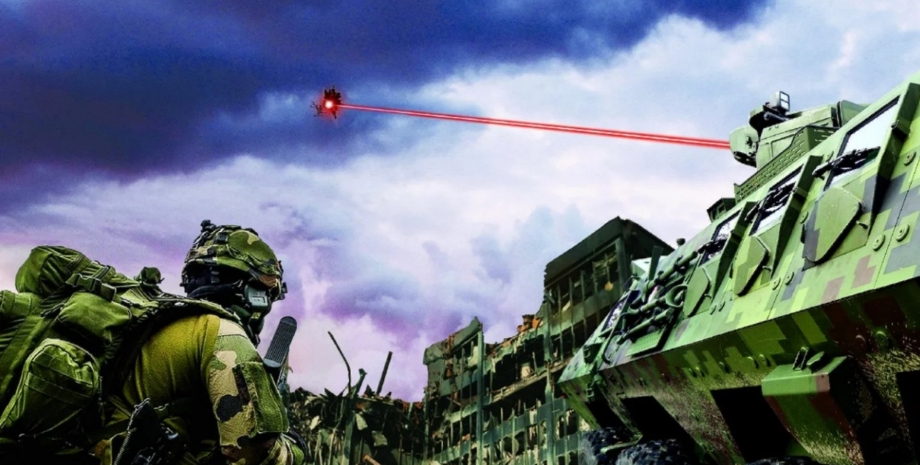
 By Natali Moss
By Natali Moss
The director of the American Center for National Security and Professor of Aerospace Sciences in Colorado at Bowlder, Ien Boyd, in his article for the publication of The Conversation explained how such systems work and why the military is needed. Energy weapons have become a popular object of science fiction before the invention of lasers, and over time many myths have formed around it.
Recently, developers have begun to test the first prototypes of real laser weapons intended primarily for the destruction of enemy drones and rockets. The laser uses electricity to create light particles (photons). These particles pass through a special material, which increases their number, after which all photons focus in a narrow beam with the help of guide elements.
The first laser was created in 1960, since then scientists have developed many systems that generate photons at different wavelengths of the electromagnetic spectrum, from infrared to ultraviolet. High -energy laser systems that use military -based, based on solid lasers with special crystals to convert input electricity into photons. Their important feature is that light particles are created in the infrared part of the electromagnetic spectrum and is not visible to the human eye.
Therefore, it is impossible to see where such weapons shoot. When the laser beam reaches an object, different effects occur depending on the wavelength of the photon, the power of the beam and the material of the surface. The distance between the emitter and the target also plays a large role. Low -flowing lasers that create visible eyelashes are used in light performances and as a pointer. They are so weak that they simply reflect from the surface and do not damage it.
More powerful lasers can cut biological tissues, so they are used in medicine. There are also those that can heat, melt and burn many different materials, they are used in industry for welding and cutting. The destructive capacity of the lasers attracted the attention of the military. One of the key advantages of high -power weapons is the endless store. Unlike traditional weapons, such as guns and guns that require ammunition recharge, the laser can fire while electricity comes to it.
The US Army uses a 50 kilowatts high -energy laser installed on a Striker infantry fighting machine, and in February 2024 launched four systems for combat tests in the Middle East. The country's naval forces, meanwhile, launched a high-energy ship's laser to protect against small and fast moving ocean surfaces, as well as rockets and drones. In August 2022, the Navy installed a 60-kilowatted laser weapon on the destroyer USS Preble.
The US Air Force is developing high -energy lasers for aircraft for defensive and offensive tasks. In 2010, they tested a megawatt laser installed on a modified Boeing 747, struck by a ballistic missile during its launch. Air Force is currently working on a smaller fighter weapon system. Russia probably develops a high -energy laser for land base to "blind" the satellites of its opponents.
One of the main problems for military lasers is the high level of power needed to defeat targets at a long distance. Unlike an industrial laser, which can be very close to the object, combat operations are carried out at a much greater distance. In order to protect against the approaching threat, such as a mortar shell or a small boat, laser weapons need to be amazed before it can harm. Tens are required to burn solid material at a considerable distance, if not hundreds of kilowatts.
The smallest prototype of laser weapons consumes a capacity of 10 kilowatts, about like an electric vehicle. Lockheed Martin is already creating a 300 kilowatts laser weapon, which is enough to power 30 houses. Since the efficiency of high -energy lasers is only 50%at best, they produce a huge amount of heat that you need to go. As a result, laser weapons require an infrastructure to produce electricity and cooling, which is why it can be installed not everywhere.
Army trucks and fighters have little space, so they can only be armed with low -power systems capable of knocking down UAVs and missiles. Ships and larger aircraft can be equipped with more powerful lasers capable of burning holes in boats and land vehicles. Land base complexes are least limited, so they can take up a lot of space, get a lot of energy and are potentially capable of attacking even satellites in space. Another important restriction is related to "ammunition".
In this case, the infinity of energy is very conditional, because the armor, ship, or aircraft for the use of laser weapons must have the appropriate power source, which also limits both power and time. There are also restrictions related to environmental conditions: rain, fog and smoke scatter laser rays, reducing the effectiveness of the lesion. In such situations, the United States will test the setting of the De M-Shorad in the Middle East.
In addition, lasers need to be killed for a few seconds to cause significant harm. Ien Boyd believes that in the future, high -energy laser weapons are likely to develop with an increase in power levels, which will expand the range of goals against which it can be used.
The threats arising from inexpensive armament drones similar to those used in conflicts in the Middle East and Ukraine increase the likelihood that high -energy lasers will also find non -military use, for example, to protect the population from terrorist attacks. Recently wrote that the US Navy want to create laser weapons with replaceable shops like rifles. Instead of ammunition, there should be batteries for quick recharge.










All rights reserved IN-Ukraine.info - 2022